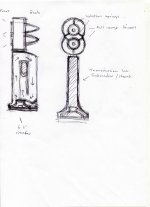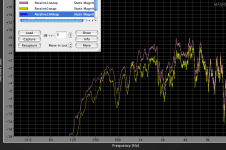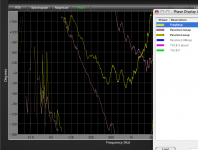I think the widely held belief is that your main speakers need to reach down to 80hz flat if using one Sub, to avoid directional issues.
What if you were using 2 subs- ie below each speaker?
How high could you theoretically go with the x/o😕
What if you were using 2 subs- ie below each speaker?
How high could you theoretically go with the x/o😕
Surely, if your subs are in the same direction as your principal sound sources all you've got is a three (or four or whatever) way system crossing over at any frequency you choose. The problems of decent transition still exist, but any directional information from the sub is more or less right (oh, all right, if you have the kick drum panned hard to one side the lows will end up central; but back in vinyl days when I did a band with a double kick drum panned wide I had a lf mix control crossing over at 180Hz, to stop the drummer throwing the arm off the turntable, and nobody ever noticed.
The directional thing is more for when you've hidden the sub under the sofa for a vibromassage (or in the water bed, mmmm) and I suspect a lot of the problem is arrival time; it just doesn't feel right for the bass feel to get to you before the ear-collected impact.
The directional thing is more for when you've hidden the sub under the sofa for a vibromassage (or in the water bed, mmmm) and I suspect a lot of the problem is arrival time; it just doesn't feel right for the bass feel to get to you before the ear-collected impact.
Larger cones have more directionality, but are still quite wide in dispersion at 80 Hz.I think the widely held belief is that your main speakers need to reach down to 80hz flat if using one Sub, to avoid directional issues.
What if you were using 2 subs- ie below each speaker?
How high could you theoretically go with the x/o😕
A horn loaded sub may be a lot more directional at 80 Hz than a front loaded top cabinet.
It is more easy to locate the source of sound when the frequency is above 100 Hz, but there is no magic cut off frequency where suddenly location of the source "goes away".
Most "subs" are fairly large and heavy, so are put on the floor/ground.
The lower the frequency, the longer the wavelength. Longer wavelengths are less affected by audience members standing or sitting in front of them, so we can get away with a steep crossover at around 100 Hz with the subs on the ground.
Move the crossover up to around 160 Hz, and vocals will be heard from the bass speakers, if the bass is left on the ground, the vocals will sound "muddy" if people stand in front of the bass bins.
If the bass and top cabinets are all elevated above head height, any crossover that works well between low and low mid speakers may be chosen.
200 Hz used to be a common crossover frequency between low and low mid speakers in both front and horn loaded systems.
But those low speakers were not called "subs".
It is more easy to locate the source of sound when the frequency is above 100 Hz, but there is no magic cut off frequency where suddenly location of the source "goes away".
Most "subs" are fairly large and heavy, so are put on the floor/ground.
The lower the frequency, the longer the wavelength. Longer wavelengths are less affected by audience members standing or sitting in front of them, so we can get away with a steep crossover at around 100 Hz with the subs on the ground.
Move the crossover up to around 160 Hz, and vocals will be heard from the bass speakers, if the bass is left on the ground, the vocals will sound "muddy" if people stand in front of the bass bins.
Thanks, this is very useful info if designing stereo subs; and interesting too.

This is a crap sketch of the design.
Its basically a sub/stand with full range speakers above. I wanted a design which doesnt take up space, looks good and sounds decent with 30 hz bass.
The stand integrates a transmission line folded in 3 with a 6.5" woofer firing downwards.
The 'satellites' which sit on top are full range 3" and the 2.5 litre cabs are suspended by springs within a frame, similar to those old classic microphones. w
Its basically a sub/stand with full range speakers above. I wanted a design which doesnt take up space, looks good and sounds decent with 30 hz bass.
The stand integrates a transmission line folded in 3 with a 6.5" woofer firing downwards.
The 'satellites' which sit on top are full range 3" and the 2.5 litre cabs are suspended by springs within a frame, similar to those old classic microphones. w
Attachments
Last edited:
Hi,
My system is built on a similar principle, but using tapped horns for bass. It works, and in June it'll be at a meet, so I'll be able to say more than "well, I think it sounds good."
Chris
My system is built on a similar principle, but using tapped horns for bass. It works, and in June it'll be at a meet, so I'll be able to say more than "well, I think it sounds good."
Chris
This is a crap sketch of the design.
Its basically a sub/stand with full range speakers above. I wanted a design which doesnt take up space, looks good and sounds decent with 30 hz bass.
The stand integrates a transmission line folded in 3 with a 6.5" woofer firing downwards.
The 'satellites' which sit on top are full range 3" and the 2.5 litre cabs are suspended by springs within a frame, similar to those old classic microphones. w
There is more moving mass in even a light cone than you may realize, the “isolation springs” shock mount will allow the top cabinets to move with their cone movement, which is not a good thing from the standpoint of intermodulation (Doppler) distortion. Of course, since you plan to use 3” speakers from 100 or 200 Hz up, IM distortion probably does not bother you anyway.
In a home listening situation, crossovers above 100 Hz or so are problematic with a tall set up as you sketched, because the low range of vocals and instruments will shift upwards and downwards depending on the pitch (notes) sung or played. This wandering vertical position ruins the stereo locational effect, and makes for an unrealistic stereo “image”.
In most music, there is very little vocal information below 80 Hz, the low note on a guitar. Choosing speakers that will allow the subwoofer(s) to be crossed around or below 80 Hz will avoid the wandering image problem.
Art
Chris wd love to see your design, sounds ace.
Art, thanks again. I didnt think about the cone movement to be honest. Hopefully the spring arrangement will be quite solid, triangulated front to back, so the cab movement will be negligable. I did some research and some of the more modern isolated mics use a kind of elastic cord which is looped around fixings.
I wanted to x/o around 120 hz but as I'm choosing either alpair 6 or JXr6's for this build, they can be set lower (I wd have to trim the square frames of the Jordan's to fit).
Art, thanks again. I didnt think about the cone movement to be honest. Hopefully the spring arrangement will be quite solid, triangulated front to back, so the cab movement will be negligable. I did some research and some of the more modern isolated mics use a kind of elastic cord which is looped around fixings.
I wanted to x/o around 120 hz but as I'm choosing either alpair 6 or JXr6's for this build, they can be set lower (I wd have to trim the square frames of the Jordan's to fit).
120 Hz at 24 dB per octave would be OK.Chris wd love to see your design, sounds ace.
Art, thanks again. I didnt think about the cone movement to be honest. Hopefully the spring arrangement will be quite solid, triangulated front to back, so the cab movement will be negligable. I did some research and some of the more modern isolated mics use a kind of elastic cord which is looped around fixings.
I wanted to x/o around 120 hz but as I'm choosing either alpair 6 or JXr6's for this build, they can be set lower (I wd have to trim the square frames of the Jordan's to fit).
Elastomeric cord has replaced springs for microphone shock mounts for good reason.
Is there any reason other than "looking cool" for the springs (which will resonate and sound like an old spring reverb)?
Art
120 Hz at 24 dB per octave would be OK.
Art
crikey, I was hoping to combine both natural and 1st order rolloff.. I know people have used JXR6's without crossovers (not played too loud), but I wd need a bit of protection if I'm playing Mudhoney. Rolloff on these starts around 115 hz, depending on cab size.
Last edited:
There are a lot of people who don't use crossovers because it is quite difficult to get them right, especially when using passive crossovers.crikey, I was hoping to combine both natural and 1st order rolloff.. I know people have used JXR6's without crossovers (not played too loud), but I wd need a bit of protection if I'm playing Mudhoney. Rolloff on these starts around 115 hz, depending on cab size.
No crossover components at all can sound far better than a bad crossover.
The actual acoustic crossover often bears little resemblance to the electrical filters applied.
Just yesterday I removed "protection capacitors" from 10 of my HF drivers, which use active crossovers. The 18 MFD capacitors were supposed to roll off the 16 Ohm drivers with a 3 dB down point at about 500 Hz, an octave below the electronic crossover.
As you can see, the capacitor did nothing like that, notice at 200 Hz, the capacitor only reduced level by 1 dB, at around 315 Hz, it does almost nothing, and it still had effect up past 4K. The attenuation below 160Hz is largely due to a 100 HZ 24 dB per octave active Butterworth filter used to keep the really low stuff from damaging the diaphragms during the test.
At no point above 160 Hz does the capacitor reduce the level by 6 dB.
The capacitor would protect the diaphragm from DC, but would do very little else.
I should get back out to the shop and rewire the polarity reversed cords that were needed with the capacitor in circuit.
Getting the phase response smooth in the crossover region required a polarity reversal (180 degrees) and delay to get it correct with the capacitor in circuit.
The capacitor phase shift was 90 degrees at around 500 Hz, but less below and more above.
A passive crossover using a capacitor to "protect" the high drivers, and "natural rolloff" of a bass cabinet will probably at best be phase correct at one frequency, and off for most of the overlap area. The wider the overlap, the worse it will sound.
Things sounded better before I knew why they sound bad :^(.
Art
Attachments
Last edited:
One of the main objectives for me is to keep crossover components to a minimum but I don't know how much protection a 1st or even 2nd order would offer if crossed at 120 hz. It might have to be a compromise and be higher, say 160 hz 1st order, but then there will be wide overlap as you said.
Last edited:
From what I've seen, first order won't give a whole lot of protection, unless you team it up with a really small sealed box (but, of course, then it might not get to 80Hz).
Some time ago, I used a 2nd order passive crossover on a pair of 3" wide-range drivers, which were mounted in a 10:1 taper transmission line, stuffed well, but open ended. Turned up to normal listening levels, the little driver was moving visibly. The crossover was at 300Hz.
Now I'm using a 4th order active crossover @80Hz on a pair of folded Voigt pipes (with FE126eNs), which provide some excursion reduction. Turned up quite loud, I can get the Fostexes to move ~3mm p/p.
As a thought, consider a vented design, and cross it over above port tuning. With a bit of luck, the crossover will have kicked in enough to reduce serious excursion below port tuning, and the port will reduce excursion at port tuning.
Chris
Some time ago, I used a 2nd order passive crossover on a pair of 3" wide-range drivers, which were mounted in a 10:1 taper transmission line, stuffed well, but open ended. Turned up to normal listening levels, the little driver was moving visibly. The crossover was at 300Hz.
Now I'm using a 4th order active crossover @80Hz on a pair of folded Voigt pipes (with FE126eNs), which provide some excursion reduction. Turned up quite loud, I can get the Fostexes to move ~3mm p/p.
As a thought, consider a vented design, and cross it over above port tuning. With a bit of luck, the crossover will have kicked in enough to reduce serious excursion below port tuning, and the port will reduce excursion at port tuning.
Chris
the little jordans wont work vented, but the alpair 6 would. I think I need to re approach the design. 🙁 as I don't want to use a 4th order, just doesnt seem right.
I think this design only works with the sub x/o at around 120 hz or so.
I think this design only works with the sub x/o at around 120 hz or so.
Last edited:
Well, I'll tell ya what, science of sound aside, I've got a a passive sub on my front 3 and 2 of the rear channels (5 bass cabinets, 7 subwoofer drivers) in my home theater rig. We blow up Praxxis (Star Trek 6, the undiscovered country) for fun, and I'd hate to think the pressure wave that rips across the living room is a figment of my imagination.
I should probably note that I use 80Hz sub crossover points on every channel.
I should probably note that I use 80Hz sub crossover points on every channel.
Last edited:
Very good point!
I am a true believer in using at least a stereo sub system.
When you start to introduce a delay or phase shift to the signals in one channel even the lowest frequency's become directional and seem to be moving across the room.
This is very eviedent in a system that is setup outside or in a large room where the standing waves are reduced enough to not interfear with the signal at the listening position.
I also found this to be true when running subs in stereo in my 1984 camaro.
Running them mono just did not do alot of different types material any justice.
Even when running the crosover below 120hz.
I normaly ran the crossover at around 140hz because that was where they mixed in seemlessly with the JBL 6X9's I was using.
Thats just my personal experience and my honest opinion from working with very small to very large and loud systems. jer
I am a true believer in using at least a stereo sub system.
When you start to introduce a delay or phase shift to the signals in one channel even the lowest frequency's become directional and seem to be moving across the room.
This is very eviedent in a system that is setup outside or in a large room where the standing waves are reduced enough to not interfear with the signal at the listening position.
I also found this to be true when running subs in stereo in my 1984 camaro.
Running them mono just did not do alot of different types material any justice.
Even when running the crosover below 120hz.
I normaly ran the crossover at around 140hz because that was where they mixed in seemlessly with the JBL 6X9's I was using.
Thats just my personal experience and my honest opinion from working with very small to very large and loud systems. jer
There is a learning curve for operation of any DSP.How easy is DSP to use?
Some user interfaces are a bit clunky, others more intuitive, each will be a bit different.
The real trick is learning what to do with the DSP.
That said, making a decent acoustic crossover using DSP is hundreds of times easier than doing it passively.
I can align a three way active system using DSP (and using Smaart) in an hour or two, while I have spent literally weeks making a decent two way passive crossover.
Art
is DSP the future? I lookied at those mini DSP boxes and I'm wondering if thats the best choice for this sub/fullrange set up.
- Status
- Not open for further replies.
- Home
- Loudspeakers
- Subwoofers
- Directional bass, sub question


